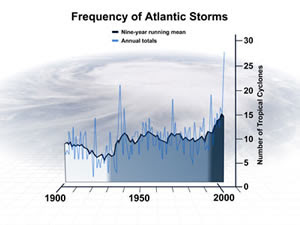
Global Warming Means More Atlantic Tropical Storms and Hurricanes
A previous post discussed how global warming seems to be increasing the intensity of Atlantic hurricanes. At that time it wasn't certain that the number of tropical storms in the Atlantic was increasing along with global warming, too. Now the evidence is in. Recent work shows that there has been a significant increase in the number of tropical storms and hurricanes in the Atlantic over the past century, and especially over the last 20 years. More detailed information is available in a slide presentation in this large pdf file.
Now the evidence is in. Recent work shows that there has been a significant increase in the number of tropical storms and hurricanes in the Atlantic over the past century, and especially over the last 20 years. More detailed information is available in a slide presentation in this large pdf file.The year 2006 was a respite after a series of recent major storms in 2004 and 2005, with only five hurricanes and four other named tropical storms. But it would have been an above average hurricane season in the early 1900s.
"These numbers are a strong indication that climate change is a major factor in the increasing number of Atlantic hurricanes," says study co-author Greg Holland of the National Center for Atmospheric Research. (See NCAR press release.) Although our ability to count tropical storms has improved a lot with the development of aircraft and satellites, "We are of the strong and considered opinion that data errors alone cannot explain the sharp, high-amplitude transitions between the climatic regimes, each with an increase of around 50 percent in cyclone and hurricane numbers, and their close relationship with SSTs," the authors state. (SSTs = sea surface temperatures, which have increased about 0.7 degrees C. in the Atlantic hurricane-forming region over the last century. The area of warm water has expanded also.)
Here is the abstract of the recent article by Holland and Webster
We find that long-period variations in tropical cyclone and hurricane frequency over the past century in the North Atlantic Ocean have occurred as three relatively stable regimes separated by sharp transitions. Each regime has seen 50% more cyclones and hurricanes than the previous regime and is associated with a distinct range of sea surface temperatures (SSTs) in the eastern Atlantic Ocean. Overall, there appears to have been a substantial 100-year trend leading to related increases of over 0.7°C in SST and over 100% in tropical cyclone and hurricane numbers. It is concluded that the overall trend in SSTs, and tropical cyclone and hurricane numbers is substantially influenced by greenhouse warming. Superimposed on the evolving tropical cyclone and hurricane climatology is a completely independent oscillation manifested in the proportions of tropical cyclones that become major and minor hurricanes. This characteristic has no distinguishable net trend and appears to be associated with concomitant variations in the proportion of equatorial and higher latitude hurricane developments, perhaps arising from internal oscillations of the climate system. The period of enhanced major hurricane activity during 1945–1964 is consistent with a peak period in major hurricane proportions.

1 comment:
Whether we were in possession of technologically advanced equipments or not that is not the question to be asked for, rather it’s time to realize that our planet is undergoing certain changes. Aspen skiing region is the finest example where officials are trying their best to save this famous sport, while, the polar ice is at risk in this century, now the question emerges, who is to blame for all these types of catastrophe? Yes, global warming, which is responsible for all such types of degeneration that is consuming our planet.
Hence, the only way to save our planet from the tentacles of global warming is to make use of renewable energy sources than the nuclear solution. After all, the developing nations too are inclining towards renewable energy.
Post a Comment